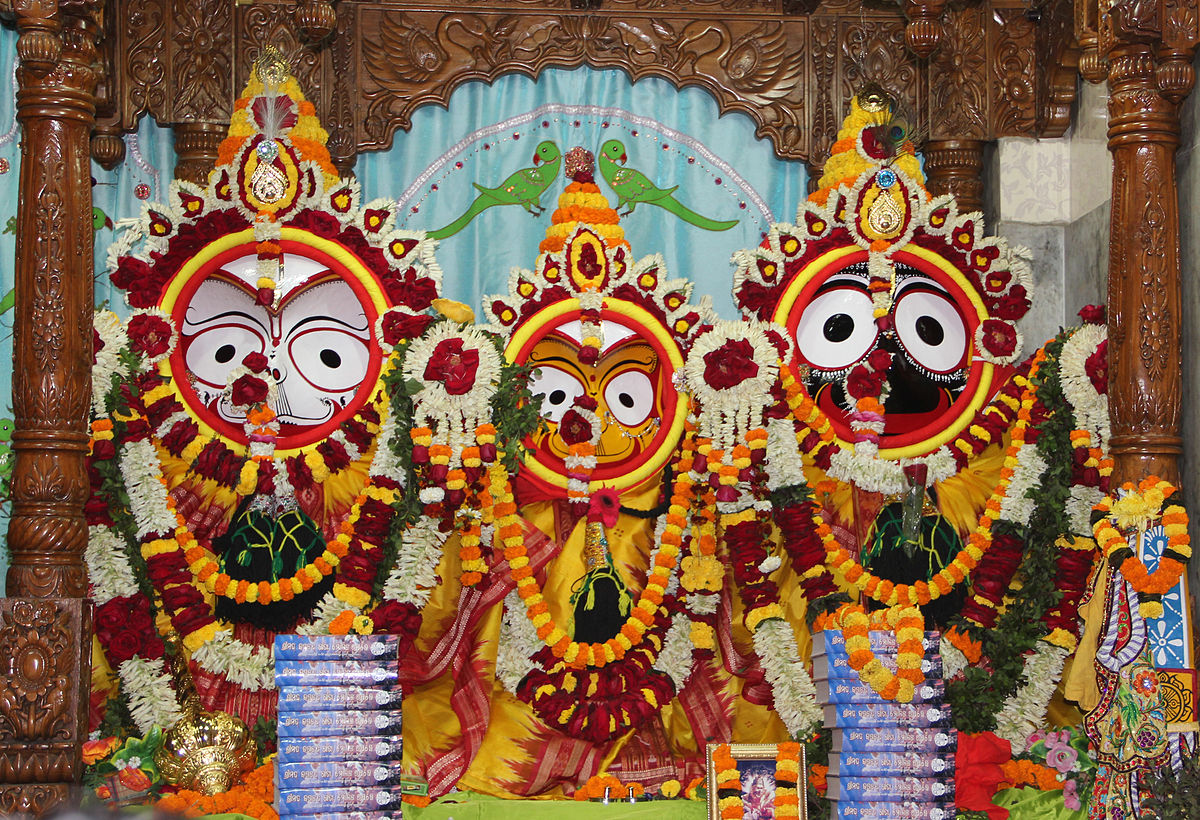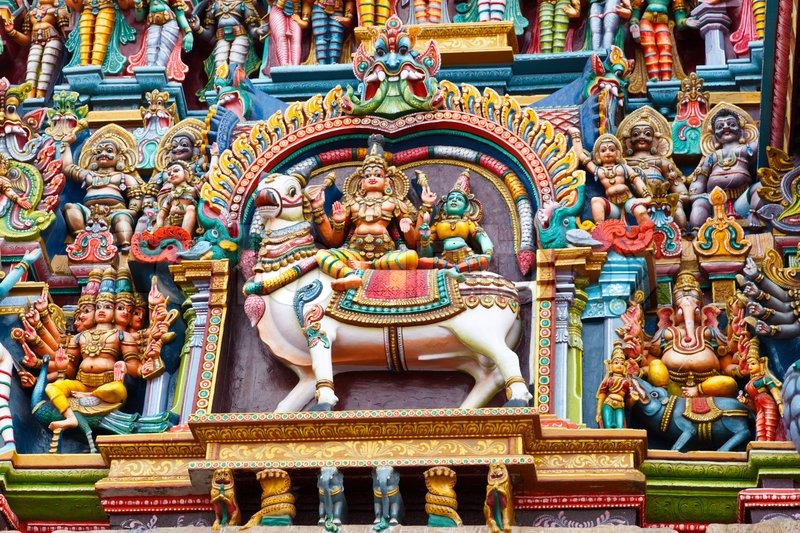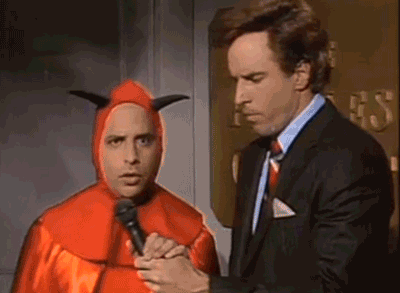The following is the second of a three-part series. The first can be found here.
Symbolically, the idea of going beyond the edge of the ordinary world to encounter other levels of reality is a recurring theme in religion and mythology. For example, Hindu mystical texts promise, via practices such as yoga and meditation, glimpses of the actual world which exists behind the facade of our commonly experienced reality (e.g. The Yoga Sutras of Patanjali). Ordinary reality is dismissed by this tradition as a delusory “veil of maya,” a sensory illusion which hides the true ground of our existence,[1] similar to Plato’s parable of the Cave in his Republic.[2] The primary function of spirituality, according to Campbell, is to assist a person in making such a transcendental leap.[3] In other words, it provides a means for breaking with conventional values that ordinarily serve as the structuring pillars of one’s lifeworld.
Going on a spiritual journey is often equated to entering a strange landscape, a liminal zone within which a person can experiment with their ‘powers’, i.e. their agency, identity, or life’s purpose. Moving oneself outside of an ordinary, and possibly disenchanted experience of life, even one that is materially or psychologically soothing, is what is being presented with this theme. And even if only temporarily, to move oneself beyond the comforts and stability of a conventional existence would, by Carroll’s definition, force a person to draw upon strengths they did not know they had.
These experiences allow one to develop and increase their range of possible actions, which prepares them for the challenges of the wasteland, a motif widely represented in mythologies.[4] For example, in the Star Wars saga (Lucas Films Ltd., 1977) Luke Skywalker, due to a disruption of his safe yet constrained life, travels beyond the limits of the familiar world, in order to begin his training as a Jedi knight. Under the direction of a wise mentor Skywalker furthers his understanding of the force, which allows him to both face and defeat his powerful enemies.
It is usually an accident, or traumatic break with one’s former lifeworld that compels the sun child to undertake their adventures. In Luke’s case, he encounters a strange wizard-knight in the desert who knows of the father he never knew. Soon after this encounter his only remaining family members are killed, leaving him with no ties to the ordinary world, and so he is propelled into a new and extraordinary phase of life. Similarly, Alice follows the White Rabbit down the rabbit hole, “never once considering how in the world she was to get out again,” and where she is promptly presented with a series of “out of the world” experiences, where “so many out-of-the-way things” happen.[5]
Random events that set a hero’s journey in motion can also be interpreted as unforeseen glitches. Technically a glitch is a failure of protocol, i.e. a malfunction. For video game users, this is defined literally as a mistake in the computer code that allows for an unintended, but interesting event to occur. For example, the glitch Neo detects in the matrix’s code provides him with a way to see through the intended structures which define the boundaries of the normal world. It is an awakening to a problem that may signal a traumatic break with reality. But it also allows for a passageway out of what might be an undesirable paradigm. In other words the glitch, or anomaly, provides an opportunity for an escape via transcendental actions.
Taking a hallucinogen has much the same effect, in both the Alice stories, and according to my informants. The mind-altering effects of a psychedelic experience produces a break with ordinary reality, one that cannot be reversed or undone, but must be seen through. Because the person has phenomenologically stepped outside of their ordinary world of references, and having seen the “other side,” they are necessarily changed. Users thus return with an altered perspective, and because these experiences are connected with notions of personal growth, presumably an expanded understanding of their world.
As in quest type video games there are keys that allow players to move to the next level. Keys are specifically designed to unlock doors, doors of the mind presumably as theorized by Aldous Huxley.[6] Psychedelics are conceived to be chemical keys, structurally configured to fit specific locks. This type of key, it is believed by participants, unlocks a chemical possibility in the brain which yields an altered state, taking the user to a higher, or different level of consciousness. Hallucinogens do not, by most definitions, contain supernatural properties, however. This differentiates them from the artifacts or rites of a satanic ritual for example.
In that case there is magic involved, e.g. speaking a sequence of words (wherein the linguistic formula contains magical properties) releases a physical force that opens up doorways. From a normal scientific perspective there is nothing supernatural about the entheogen, only its chemical properties that allow it to have particular physiological effects. But for my subjects these can also be magical, insofar as nature, which includes the plant derived hallucinogens, as well as video games, are all part of a divine program or paradigm. For lack of a better term it is ‘magic’, or ‘spirituality’ that cosmically connects hallucinogens with human consciousness and occurrences in the world, all of which have metaphysical, as well as physical properties.
Out of the Way Places: Where am I?
By placing Alice in a series of nonsensical situations, Carroll also highlights the contrast between a rational and reserved posture, embodied by a tight-laced English schoolmaster on the one hand, and the manic unreasonableness of a “Mad Hatter” on the other. This play of opposites is exhibited in other popular media. For example, in the science fiction series Star Trek (created by Gene Roddenberry, Paramount Pictures, 1966-69), the rational and unemotional extraterrestrial Mr. Spock, is contrasted with the emotional and compassionate humanitarian Dr. McCoy, and the spontaneously intuitive commander Captain Kirk. In the Star Trek Universe Vulcans are highly logical, having learned to suppress their emotions. They also possess superior intelligence, as well as superhuman strength.
Aliens such as these are often depicted in fictional narratives as being more advanced than humans, presumably due to the aforementioned qualities. This is precisely what Carroll rebels against: Enlightenment notions of progress that have encoded within them Darwinian ideals that equate ‘logical’ with ‘superior’. This western scientistic trope projects onto the world a unilineal pattern of development, in which cruder forms of life evolve into more sophisticated ones.
For example, indigenous cultures were viewed, in Carroll’s time, as less developed than European ones. Primitive peoples were also seen as less intelligent and more emotional, even child-like in comparison with Europeans,[7] and these ideals found their way into 20th century science fiction. Being more advanced roughly equates to being more logical, having a higher intelligence, and being less emotional. In other words, rationalist atheism is valued over adherence to either religion or superstition. James Frazier’s cognitive theory of religion suggests that they evolve from simpler forms to more complex ones, with the implication that atheism is “after” and “beyond” religion, thus being a superior belief system.[8]
This logocentric bias is partly what Carroll seeks to romantically undo, in part by praising emotive pre-logical thought, and child-like forms of consciousness, while parodying overly logical or rational temperaments. Robert Ellwood interprets mythological meanings from such a romantic perspective. He suggests that, “myths relate truth not just in a literary or proto-scientific way, but go behind all that to embody the primal, almost pre-verbal consciousness of the human race ‒ or of a particular race‒ in its sunset years when our ancestors were trailing clouds of glory, and the shadows of the prison house had not yet closed around. Myth comes first; abstract language is only faded mythology”.[9]Wonderland: Nightmare or Sanctuary
Wonderland: Nightmare or Sanctuary?
The Caterpillar
The Caterpillar asks Alice “who are you?” to which she responds, “I don’t know quite who I am, or how I am supposed to be,” a condition that highlights her identity confusion. She continues “Am I the same as I was yesterday? How queer everything is today, I wonder if I’ve been changed in the night. Let me think, was I the same as when I got up this morning? If I’m not the same, the next question is, who in the world am I?”.[10]
A pivotal moment occurs in the narrative when Alice exclaims, in response to the Caterpillar’s disturbing provocations, “I can’t explain myself I’m afraid, Sir, because I’m not myself you see”.[11] Being in a strange place, where her old self ceases to work, Alice is unsure about who she is. Finding herself in an alternate reality, with different rules and expectations, she becomes estranged from her former self, which was part of the above-ground world. At this point she begins to acknowledge, with an increasing awareness, that her identity is contingent upon the discursive world in which she finds herself.[12] Individuals in my study sample often see this moment as revelatory, the point in their journey which marks the separation between their inherited culture, and their desired one. In a perhaps yet to be determined place, individuals seek to establish a new sense of self. This is a self apart from the one shaped by the discourses and identities received from one’s family group or society, such as daughter, son, Christian, Muslim, American, consumer, etc.
Part of the motivation for using entheogens is to get to this place of identity independence. The alternative spaces in which this type of identity work occurs, such as spiritually oriented cosplay festivals, are analogous to the underground worlds of Wonderland, which likely accounts for the latter’s psychonautic appeal. Psychedelics open up alternative worlds, and the resulting visions, according to my informants, often become the inspiration for intentional communities themselves, which are places designed to be socially and psychologically transformational. In a way, these spaces can be conceived of as cultural cocoons, in which individuals undergo personal metamorphoses.
These communities are also protected spaces, insofar as they are usually isolated and off the beaten track, places in which individuals feel safe experimenting with themselves existentially, phenomenologically, expressing themselves in ways that are typically unavailable in mainstream life. This can involve alternative dress, practicing nudity, gender fluidity, or engaging in rituals that involve a sexual dimension. So behaving strangely, and in conjunction with the use of hallucinogens, have the effect of opening up “avenues of experience previously unavailable to the individual”.[13] Engaging in these liminal practices may serve to shift one’s center of awareness, pushing the individual into new social and psychological territory, and priming them for shifts in consciousness and identity transformation.
Alice then tries to assess whether or not she has changed by attempting to recite her multiplication tables. However, as she tries to do this, everything comes out all wrong, “Four times five is twelve, four times six is thirteen” and “London is the capital of Paris”.[14] Things that were previously relied upon to provide corporeal stability no longer work, “and with so many familiar, comforting concepts already lost, Alice naturally begins to sense her frightening isolation, and alienation from the self-defining constructs of above-ground culture”.[15]
Perhaps, more than anything else in the story, individuals in my study sample most identify with Alice as she cries aloud, “I am so very tired of being all alone here!”.[16] Being on an individual spiritual journey has its advantages: not being bound by prepackaged religious systems that are ill-fitting, being free to map out one’s own direction and goals based on personal interests and inspirations, not to mention the solitude this brings one. But from talking with my informants, I get the sense that many of them feel as alone as Alice does, although probably for different reasons. Both are trapped in a strange and hostile environment, bewildered and unsure about who they are or what they should do.
However, for Alice it is the above-ground world that provides solace and stability, and an eventual escape from an unpleasant and maddening underworld. For my study participants it is the ordinariness of the normative, or “muggle” world in which they feel the most alienated, and so attempt to create alternative worlds to flee into. Rather than seeing Alice’s plight as a cautionary tale, as something to be anxiously avoided, informants are envious of her ability to peek behind the veil as it were, to see what exists on the other side. This is a notion emphasized perhaps more so in Alice’s adventures Through the Looking Glass, wherein she returns to the magical possibilities fellowship of Wonderland.
Who am I? Identity Confusion, Transformation, and Incorporation
The Caterpillar asks her again, “Who are you?” Alice answers, “I’m afraid I don’t know at the moment, I know who I was when I got up this morning, but I think I’ve changed several times since then”.[17] This dialogue is a favorite among psychonauts, and so I include from it the following excerpt, as it probes more deeply into identity change and its relation to narrative structures. Especially pertinent themes include the disorienting effects of change, and the warping of ‘the real’:
Caterpillar: ‘So you’re thinking of changing again are you?’
Alice: ‘I’m afraid I am, you see I can’t remember the things I used to?’
Caterpillar: ‘What size do you want to be?’
Alice: ‘I’m not particular to size, it’s just that one doesn’t like changing so often you know.’
Caterpillar: ‘No I don’t know, are you happy now?’
Alice: ‘Well I’d like to be a little larger.’
Caterpillar: ‘Hmm seems a very nice size to me.’
Alice: ‘I’m not used to it.’
Caterpillar: ‘You’ll get used to it.’
Alice: ‘And being so many different sizes in a day is very confusing.’
‘It isn’t,’ said the Caterpillar.
‘Well, perhaps you haven’t found it so yet,’ said Alice; ‘but when you have to turn into a chrysalis — you will someday, you know — and then after that into a butterfly, I should think you’ll feel it a little queer, won’t you?’
‘Not a bit,’ said the Caterpillar.
‘Well, perhaps your feelings may be different,’ said Alice; ‘all I know is, it would feel very queer to me.’
The Caterpillar is, of course, familiar with change. His ability to metamorphose represents both transformation and maturation. Also, because a butterfly is a radically different form of life compared to a caterpillar, a total alteration of one’s self. Alice worries about changing however, and wonders how much does one have to change before having a new identity? In Through the Looking Glass for example, when Alice is about to enter the forest of no names, she is worried about losing her name. Moreover, due to Carroll’s linguistic topsy-turvydom, Alice experiences a type of ontological insecurity. She is plunged into a semiotic chaos where “things slip away from words”.[18]
Words become separated from their referents, and effects are severed from their causes. For example, because her name and identity have always been connected and interdependent, she considers them inseparable. Therefore, the loss of one signifies losing the other, which justifies her fears. However, when Alice encounters Tweedledum and Tweedledee, the loss of her name becomes less about losing her identity, and more a concern about receiving an ugly name: “I shouldn’t like to lose it at all–because they’d have to give me another, and it is almost certain to be an ugly one”.[19]
Beckman argues that the lack of character continuity is linked to the lack of narrative continuity. By disrupting continuity, the text forces Alice “to let go of the continuity of her own and the world’s identity”.[20] Eventually Alice stops trying to predict or explain events, using her above-ground knowledge and logic, and learns rather to act upon them in the moment. In the same way individuals may seek to disrupt the normative narrative structures, i.e. the cultural texts, in which they find themselves. Beckman asks, “how is our freedom and capacity to act curtailed or encouraged through narrative structures?”.[21]
Non-Linearity and Metamorphosis
Something unusual in the Alice stories, and no doubt an attractive feature for many of my informants, is that they jump from scene to scene without a logical progression of events. There are disconcerting breaks in causality, wherein characters appear and disappear suddenly and mysteriously. This contrasts with typical narratives, in which “acting becomes a matter of creating a linear and causal chain through which identity is secured”.[22] Carroll deliberately upsets standard forms of narrative structure by introducing elements of “nonsense,” such as abrupt jumps or breaks in the storyline. Things often seem to run backwards, as when the Hatter accuses Alice of not being the same as she was before, with statements such as “you were much muchier,” and “you’ve lost your muchness”.[23] As the story proceeds, Alice becomes “muchier” as she overcomes the successive challenges posed by Wonderland. In this case identity is the vehicle that connects past states with future ones.
The idea of an expanding and contracting self is implicit in the New Age notion of the “capital S self,” i.e. the future, larger, more evolved and more complete self which is contained, in a nascent form, within the current and less developed self. It is believed that the individual, via their spiritual practices, will gradually ascend a karmic ladder into higher states of selfhood. An important aspect of my subject’s brand of religiosity is defined by this developmental process, i.e. acquiring what they consider to be higher levels of spiritual status. It is connected with Hindu notions of reincarnation as well. On the one hand a person becomes more than what they were, due to having transcended their previous set of cultural, moral, or behavioral limitations. But they also become more of what they already are: through actualizing inner potentials an individual achieves their (until this moment) unrealized totality, i.e. their god-self.
In one sense Alice is not herself anymore, but in another she is not herself yet. She continually defines who she is by the ways in which she responds to the trials that have been set for her. Having been stretched and shrunk multiple times, and having her moral and causal universe turned upside down and inside out, she is no longer her once naïve self. The changes in size are symbolic of her liminal transformations, from which she emerges primed for the discovery of just who she is. Through immersing themselves in ritual practices such as entheogen use, and liminoid space activities such as New Age and neopagan cosplay ritual events, my study participants similarly affect a dissolution of their previous selves, or ego identities. Donning costumes, embodying new roles within an orchestrated social event, wherein one has a designated ritual function that serves a meaningful purpose and is important to other members, e.g. a Druid priest or Fairy guide, provides opportunities for individuals to work out a new sense of who they are.
The final stage, which completes identity transformation within a traditional culture, is called incorporation. This occurs when a person reaches full adult status. Having survived the numerous trials and challenges put to them, and with the successful completion of their rites of passage, an initiate moves from liminality to incorporation. They receive a new name and rank within their societies, along with new responsibilities.[24] Among my study participants, achieving a new identity is often equated with undergoing a kind of rebirth.
Ironically it is their old identity, the one given to them by their parent culture, which they seek to transcend. Because one’s old identity is perceived as being produced by mainstream societal norms, it is as if the person, through developing their new self, sheds the skin of an earlier stage of life, one associated with the muggle world, to become more fully realized as their magical self. By taking the psychonautic journey, the individual experiences a shift in perspective, a shift in how they perceive and understand the world, and how they see themselves in relation to it.
John Cuda is Assistant Professor of Sociology and Criminal Justice at Lincoln University. He holds a PhD from the University of Pittsburgh.
[1] Joseph Campbell, The Masks of God: Creative Mythology, (New York: Penguin, 1968), 79.
[2] Plato, Republic, (Indianapolis: Hackett Publishing Company, 1992), BK VII, p. 186.
[3] “The Message of the Myth,” Power of Myth (Pittsburgh: PBS, June 1988).
[4] Campbell 1968, 388.
[5]Lewis Carroll, Alice’s Adventures in Wonderland (1865), (London: Puffin Classics, 1994), 2.
[6] Aldous Huxley, Doors of Perception, (New York: Harper-Collins, 1954).
[7] Bailey and Peoples, 93-94.
[8] James Frazier, The Golden Bough: A Study in Magic and Religion, (London: Oxford, 1890).
[9] Elwood, 37.
[10] Carroll 1994, 14.
[11] Carroll 1994, 44.
[12] Rackin, 46.
[13] Huxley 1954.
[14] Carroll 1994, 15.
[15] Rackin, 41.
[16] Carroll 1994, 16.
[17] Carroll 1994, 44.
[18] Beckman, 9, 141.
[19] Lewis Carroll, Alice’s Adventures in Wonderland and Through the Looking Glass and What Alice Found There (1871), (Berkeley: University of California Press, 1982), 209.
[20] Beckman, 2.
[21] Beckman, 8.
[22] Beckman, 16.
[23] Carroll 1982.
[24] Bailey and Peoples 2015.




